| |
|
| |
|
This is a sparsely
populated part of Suffolk, the rolling landscape
with its fields and copses punctuated by the
occasional settlement. The medieval parish
churches are often remote, and Sotherton's is no
exception. There is a footpath to it marked from
the Halesworth road, but on the one occasion I
took it I ended up lost in a farmyard, and ended
up having to go the long way round. A narrow lane
rises up from the Beccles road, and it was with
some surprise in October 2018 that I cycled up
this to overtake a man struggling to push a
cement mixer. He stopped for a rest, and we said
hello. I asked him if he was alright, and he said
he was, or at least he would be when he got it to
the top of the rise. This was where the church
was, and the lane finishes just beyond it, but I
saw him carry on with his cargo, so I don't know
where he was going.
There is no village. Even the Parish of Sotherton
is too small to be marked on anything but a
decent Ordnance Survey map. The only other
buildings in sight are a cottage on the edge of
the churchyard, and an old farmhouse beyond. The
farmhouse's position in relation to St Andrew
gives it a proprietorial air, and you feel that
in times past the church might actually have been
an organic part of the farmyard complex, as at
Letheringham. The fields lift around to enfold
the little church, and when the corn is as high
as a cyclist's eye it gives an intensely
secretive feel to the place, as if something
buried deep in the past is hidden here. If you
come here while the harvest is in progress it can
feel as if the land is being stripped back to
reveal a profound secret.
This charming little church was completely
rebuilt by the Victorians. But they reused the
old materials, and at any rate this is a church
worth visiting. It is a fine example of good 19th
century rural work. The architect was Henry
Ringham, most familiar from his superb wood
carving in the Ipswich area, particularly at
Woolpit and Great Bealings. He built the fabulous
Gothic House in east Ipswich, but went bankrupt
before he was able to take up residence. However
he was still considered a significant enough
Ipswicher at the turn of the century to have a
road named after him.
I was disappointed to find the churchyard devoid
of sheep. On one memorable occasion I had arrived
here to find the church playing host to a flock
of the friendliest and most inquisitive sheep I
have ever encountered. They rubbed themselves
against me like sleek cats, and generally did all
that they could to get in my photographs. I spent
longer looking at the outside of the church than
I did the inside, and quite missed them when I
had to cycle off in the direction of Uggeshall.
For such a quiet and unassuming church, without a
tower or a prominent position, St Andrew is full
of interest. It has at least one surprise, and
one great treasure. This is a pair of surviving
panels of the roodscreen. They are attached to
the vestry door. Although they have clearly been
overpainted, they retain their 15th century
gessowork (plaster of Paris attached to wood or
stone, and then painted). More remarkably, St
John is accompanied by his symbol of an eagle.
This is one of only two times this symbol is
known to survive on a roodscreen panel in East
Anglia.
There are other medieval survivals. The font is a
good example from the eve of the Reformation,
with a hint of the elegance which the English
Renaissance might have brought if we had not
chosen the Puritan path instead. The blockish
early 17th century font cover is a rustic
contrast.The surprising survival is the 13th
Century effigy of a knight, sleeping soundly in a
recess on the north wall. The matching recess on
the south side is empty, but is was probably
simply a Victorian affectation to have two of
them.
The 19th Century glass is singular. It is an
unusual collection. Although it must date from
the 1850s, some of it appears earlier, because of
its pre-ecclesiological style. Perhaps that is
simply because this is such a backwater. There
has been some confusion about the workshops
involved, but James Bettley revising Pevsner
teased out the details. The most striking window,
depicting the Ascension of Christ and the Day of
Pentecost, is by the Liverpool firm of Forrest
& Bromley. In a similar style on the other
side is the Transfiguration by Ward & Nixon.
The Pentonville workshop of Charles Hudson was
responsible for the window depicting St Andrew
and the Good Samaritan, his also the Wise and
Foolish Virgins sequence.
Another period piece is the painted reredos, now
reset on the north nave wall. It depicts a sparse
crucifixion, and was made for the church by
Laurence Carrington Grubbe, and installed here in
1903.
On this beautiful sunny day in late October, the
church was full of light, the stone and wood
dusty, the plaster crumbling. A rough and ready
place to be sure, but with a sense of its past
and a feeling that it is still watched over by
its present custodians. An odd addition since my
last visit was a child's coffin in the chancel
with (I kid you not) a headless statue inside it.
I'm not sure what that is all about.
Munro Cautley was harsh about St Andrew, reviling
its 19th Century rebuilding, and of course it is
an insignificant church in comparison with the
remarkable treasure of nearby Westhall. But I
think this church is lovely. What's more, it is
still in use, welcoming to strangers, and a
delightful survival of the sentiments and
impulses of our recent ancestors, just out of
sight.
|
|
|
Simon Knott, November 2018
Follow these journeys as they happen at Last Of England
Twitter.
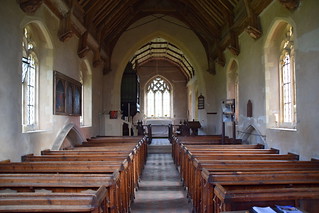 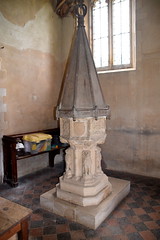
 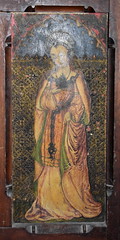 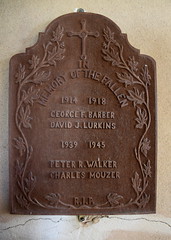 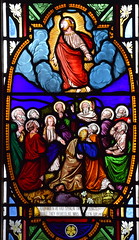 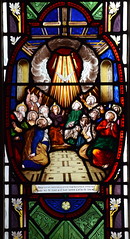
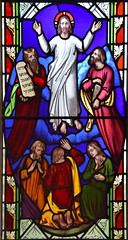 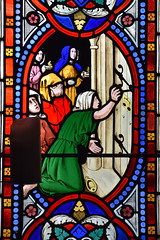 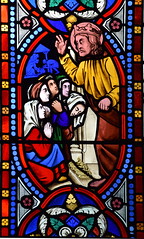  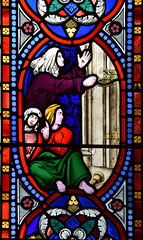
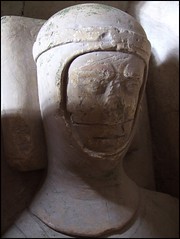 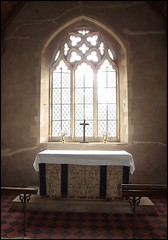 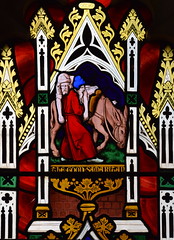 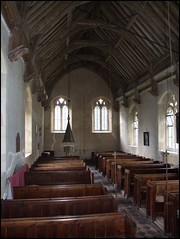
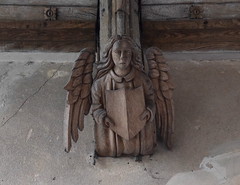 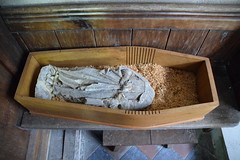 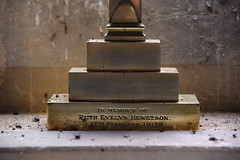

Amazon commission helps cover the running
costs of this site
|
|
|

